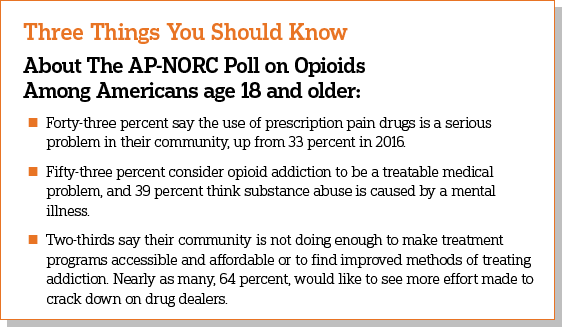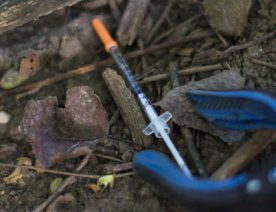
More Americans see opioid addiction as a significant issue for their community today than in 2016, according to a recent survey by The Associated Press-NORC Center for Public Affairs Research. Forty-three percent of Americans say the use of prescription pain drugs is a serious problem in their community, up from 33 percent two years ago. Additionally, 37 percent see heroin as a serious concern locally, up from 32 percent in 2016.
According to the Centers for Disease Control and Prevention (CDC), the opioid epidemic in the United States is spreading across the country and affecting Americans of all kinds, with two-thirds of drug overdose deaths in 2016 involving a prescription or illegal opioid.
Moving from the community into the home, a majority of Americans report having experience with substance abuse of various types, and 13 percent have had a relative or close friend die from an opioid overdose.
Although 53 percent of the public sees prescription drug addiction as a disease, many regard addiction as a behavioral failing instead. Forty-four percent say opioid addiction indicates a lack of willpower or discipline; 32 percent say it is caused by a character defect or bad parenting. And less than 1 in 5 Americans are willing to associate closely with someone who is addicted to prescription drugs as a friend, colleague, or neighbor.
Certain types of opioid messaging are prevalent on social media. Of the 74 percent of adults who report using Facebook, 41 percent say they have seen messages about the opioid epidemic or death from overdoses. Fewer users of Twitter, Instagram, or Snapchat have seen messages about the problem of opioids. Fewer than 1 in 10 users of any platform have seen offers to purchase opioids on social media platforms.
The federal government will spend a record $4.6 billion this year to tackle the opioid epidemic, allocating funding across agencies to help states and local governments in efforts toward prevention, treatment, and law enforcement initiatives. And most Americans agree that their communities need the funding, saying local agencies aren’t doing enough to tackle the epidemic, according to the survey.
The nationwide poll was conducted March 14-19, 2018 using the AmeriSpeak® Panel, the probability-based panel of NORC at the University of Chicago. Online and telephone interviews using landlines and cell phones were conducted with 1,054 adults. The margin of sampling error is plus or minus 4.1 percentage points for all respondents.




